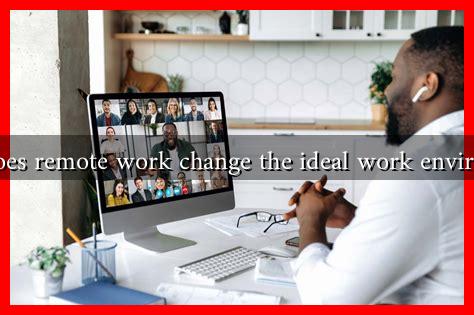-
Table of Contents
How Does Remote Work Change the Ideal Work Environment?
The rise of remote work has transformed the traditional workplace, leading to a reevaluation of what constitutes an ideal work environment. As companies adapt to this new normal, understanding the implications of remote work on employee productivity, collaboration, and overall job satisfaction is crucial. This article explores how remote work reshapes the ideal work environment, supported by relevant examples, case studies, and statistics.
The Shift in Work Culture
Remote work has significantly altered the work culture in many organizations. The flexibility it offers has led to a more results-oriented approach, where employees are evaluated based on their output rather than the hours spent in an office. This shift has several implications:
- Increased Flexibility: Employees can choose their working hours, allowing them to balance personal and professional responsibilities more effectively.
- Focus on Results: Companies are increasingly prioritizing productivity and outcomes over traditional metrics like attendance.
- Work-Life Balance: Remote work can lead to improved work-life balance, reducing stress and burnout.
According to a survey by Buffer, 98% of remote workers would like to work remotely at least some of the time for the rest of their careers, highlighting the demand for flexible work arrangements.
Redefining Collaboration and Communication
In a remote work environment, collaboration and communication take on new forms. Traditional face-to-face interactions are replaced by digital communication tools, which can both enhance and hinder collaboration.
- Digital Tools: Platforms like Slack, Zoom, and Microsoft Teams have become essential for maintaining communication and collaboration among remote teams.
- Asynchronous Communication: Remote work often leads to asynchronous communication, where team members may not be online simultaneously. This can foster independence but may also lead to delays in decision-making.
- Virtual Team Building: Companies are investing in virtual team-building activities to maintain camaraderie and team spirit, which are crucial for a cohesive work environment.
A case study from GitLab, a fully remote company, shows that they have successfully built a strong culture of collaboration through well-defined processes and regular check-ins, demonstrating that effective communication can thrive in a remote setting.
Impact on Employee Well-Being
The ideal work environment is one that promotes employee well-being. Remote work can have both positive and negative effects on mental health and job satisfaction.
- Positive Effects: Many employees report feeling less stressed without the daily commute and enjoy the comfort of working from home.
- Negative Effects: Conversely, remote work can lead to feelings of isolation and disconnection from colleagues, which can negatively impact mental health.
- Support Systems: Organizations are increasingly recognizing the need for mental health support, offering resources such as counseling and wellness programs to help employees cope with the challenges of remote work.
According to a study by the American Psychological Association, remote workers reported higher levels of job satisfaction, but also noted the importance of maintaining social connections to combat feelings of isolation.
Creating the Ideal Remote Work Environment
To adapt to the changes brought about by remote work, organizations must focus on creating an ideal remote work environment. Here are some strategies:
- Invest in Technology: Providing employees with the necessary tools and technology to perform their jobs effectively is crucial.
- Encourage Flexibility: Allowing employees to set their own schedules can lead to increased productivity and job satisfaction.
- Foster a Strong Culture: Regular virtual meetings, team-building activities, and open communication can help maintain a strong organizational culture.
Companies like Zapier and Automattic have successfully implemented these strategies, resulting in high employee satisfaction and retention rates.
Conclusion
The shift to remote work has fundamentally changed the ideal work environment, emphasizing flexibility, results-oriented performance, and the importance of communication. While remote work offers numerous benefits, it also presents challenges that organizations must address to ensure employee well-being and productivity. By investing in technology, fostering a strong culture, and prioritizing mental health, companies can create an ideal remote work environment that meets the needs of their employees. As we move forward, understanding and adapting to these changes will be essential for organizations aiming to thrive in a remote-first world.
For more insights on remote work and its impact on the workplace, visit Forbes.

